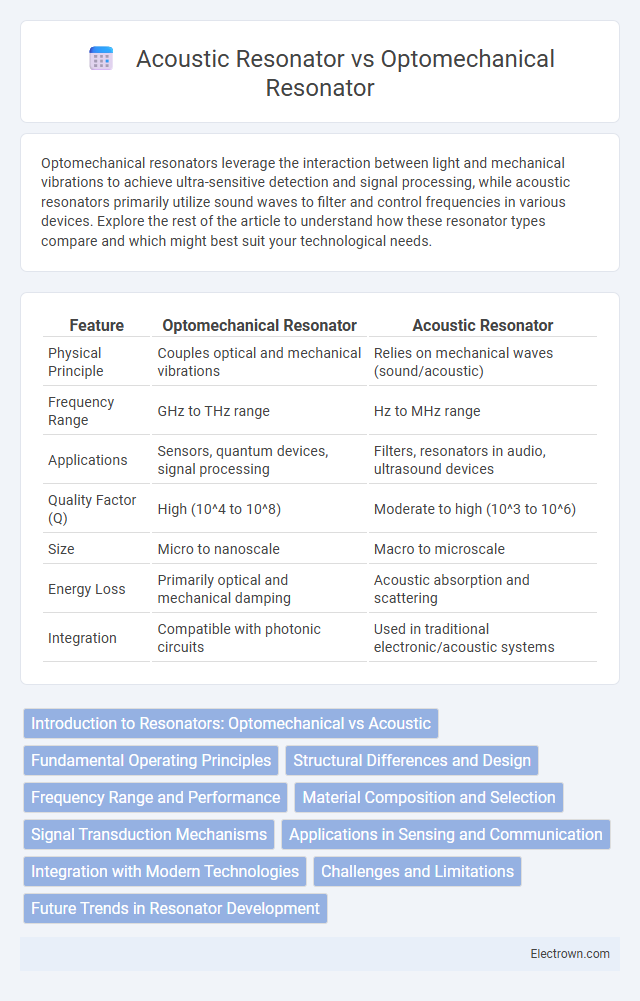Optomechanical resonators leverage the interaction between light and mechanical vibrations to achieve ultra-sensitive detection and signal processing, while acoustic resonators primarily utilize sound waves to filter and control frequencies in various devices. Explore the rest of the article to understand how these resonator types compare and which might best suit your technological needs.
Table of Comparison
| Feature | Optomechanical Resonator | Acoustic Resonator |
|---|---|---|
| Physical Principle | Couples optical and mechanical vibrations | Relies on mechanical waves (sound/acoustic) |
| Frequency Range | GHz to THz range | Hz to MHz range |
| Applications | Sensors, quantum devices, signal processing | Filters, resonators in audio, ultrasound devices |
| Quality Factor (Q) | High (10^4 to 10^8) | Moderate to high (10^3 to 10^6) |
| Size | Micro to nanoscale | Macro to microscale |
| Energy Loss | Primarily optical and mechanical damping | Acoustic absorption and scattering |
| Integration | Compatible with photonic circuits | Used in traditional electronic/acoustic systems |
Introduction to Resonators: Optomechanical vs Acoustic
Optomechanical resonators exploit the interaction between light and mechanical vibrations to achieve high sensitivity in sensing and signal processing applications. Acoustic resonators rely on mechanical vibrations within a material or structure to filter and amplify sound waves, commonly used in audio and communication devices. Your choice between optomechanical and acoustic resonators depends on factors like frequency range, sensitivity, and integration with optical or electronic systems.
Fundamental Operating Principles
An optomechanical resonator operates by coupling optical and mechanical modes, where light confined in a cavity interacts with mechanical vibrations to modify resonance properties. Acoustic resonators function by confining sound waves within a medium, relying on mechanical vibrations and their resonance at specific frequencies to amplify or filter signals. Understanding the fundamental operating principles of both resonators enables you to select the best device for applications in sensing, signal processing, or communication systems.
Structural Differences and Design
Optomechanical resonators utilize the interaction between light and mechanical vibrations within micro- or nanoscale optical cavities, often featuring photonic crystal structures or microdisks that confine both photons and phonons. In contrast, acoustic resonators rely on mechanical wave propagation within bulk materials or layered thin films, typically designed as quartz crystals, surface acoustic wave devices, or bulk acoustic wave structures with precise geometric dimensions to control vibrational modes. Your choice between optomechanical and acoustic resonators depends on the desired frequency range, sensitivity, and integration level, as optomechanical resonators excel in optical signal coupling while acoustic resonators offer robust mechanical stability and well-established fabrication techniques.
Frequency Range and Performance
Optomechanical resonators operate primarily in the MHz to GHz frequency range, offering ultra-high quality factors and exceptional sensitivity for detecting minute forces and displacements. Acoustic resonators typically function within the kHz to low MHz range, excelling in applications requiring robust mechanical vibrations and frequency stability. The high-frequency performance of optomechanical resonators enables advanced signal processing and quantum information applications, while acoustic resonators provide reliable performance for sensing and communication technologies.
Material Composition and Selection
Optomechanical resonators typically utilize materials such as silicon, silica, and diamond due to their high optical quality factors and mechanical stiffness, enabling precise control of light-matter interactions. Acoustic resonators often employ piezoelectric materials like quartz, lithium niobate, and aluminum nitride, which efficiently convert electrical signals into mechanical vibrations critical for acoustic wave propagation. Understanding your material composition needs ensures optimal performance by balancing optical or acoustic properties with environmental stability and fabrication feasibility.
Signal Transduction Mechanisms
Optomechanical resonators transduce signals by coupling optical fields with mechanical vibrations, enabling high-sensitivity detection through radiation pressure-induced mode shifts. Acoustic resonators rely on mechanical wave propagation within materials, converting input signals into measurable acoustic modes via piezoelectric or electromechanical interactions. The optomechanical approach offers enhanced tunability and optical readout advantages over traditional acoustic signal transduction mechanisms.
Applications in Sensing and Communication
Optomechanical resonators leverage light-matter interactions to achieve high sensitivity in detecting minute forces, masses, and displacements, making them ideal for precision sensing in quantum computing and biochemical detection. Acoustic resonators utilize mechanical vibrations to filter and process signals in RF communication systems and gas sensing, offering robustness and integration into microelectromechanical systems (MEMS). Your choice between optomechanical and acoustic resonators depends on the required sensitivity, operational frequency, and integration level for specific sensing and communication applications.
Integration with Modern Technologies
Optomechanical resonators provide seamless integration with photonic circuits, enabling efficient coupling between optical and mechanical modes essential for quantum computing and sensing applications. Acoustic resonators, commonly used in RF filters and sensors, offer strong integration with electronic devices through MEMS technology but face challenges in scaling for photonic applications. Advances in optomechanics leverage silicon photonics platforms, promoting compatibility with existing semiconductor manufacturing processes for scalable, high-performance hybrid systems.
Challenges and Limitations
Optomechanical resonators face challenges such as optical absorption leading to heating and limited mechanical Q-factors due to material imperfections, impacting sensitivity and stability. Acoustic resonators encounter limitations in bandwidth and increased energy loss from acoustic damping and anchor losses, reducing their performance in high-frequency applications. Both resonator types require advanced fabrication techniques to minimize defects and optimize coupling efficiency for enhanced functionality.
Future Trends in Resonator Development
Optomechanical resonators are advancing through integration with nanoscale photonic circuits, enabling ultra-sensitive detection and quantum information processing, while acoustic resonators focus on enhanced material engineering to improve frequency stability and miniaturization for mobile and IoT applications. Hybrid systems combining optomechanical and acoustic resonators aim to leverage low-loss mechanical vibrations with strong light-matter interactions, propelling innovations in sensing and signal processing technologies. Future trends emphasize scalable fabrication techniques and AI-driven design optimization to achieve ultra-high Q-factors and tunability across diverse frequency ranges.
optomechanical resonator vs acoustic resonator Infographic

 electrown.com
electrown.com